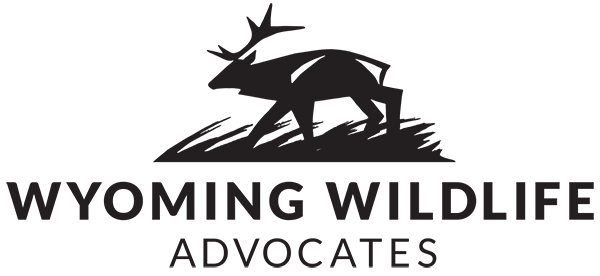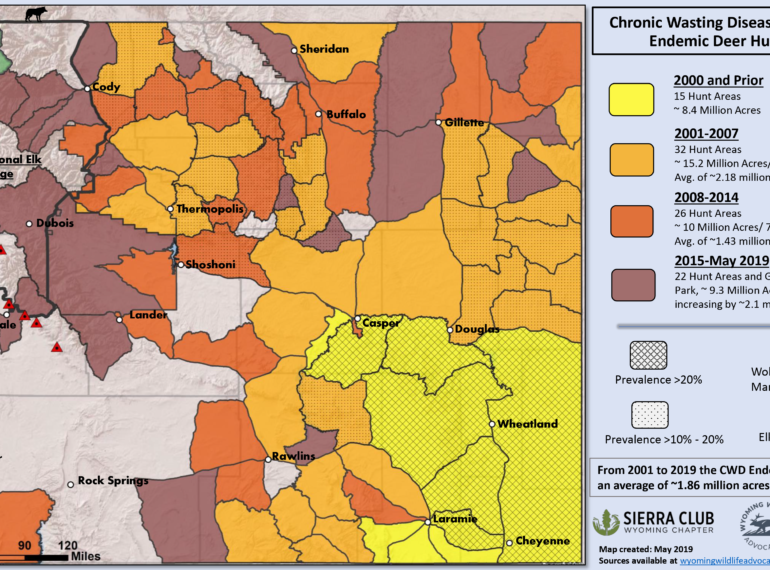For Immediate Release
May 29, 2019
Contact: Lloyd Dorsey, Sierra Club Wyoming Chapter, 307-690-1967 lloyd.dorsey@sierraclub.org
Kristin Combs, Wyoming Wildlife Advocates, 307-413-4116 Kristin@wyomingwildlifeadvocates.org
Maps Show Continued Rapid Expansion of Chronic Wasting Disease in Deer and Elk Areas Across Wyoming
Conservationists urge prompt action to restore healthy wildlife
Jackson Hole, WY – Chronic wasting disease (CWD), a fatal infection in deer, elk and moose, has expanded into Grand Teton National Park and ever closer to Yellowstone National Park in recent years. Updated maps created by Wyoming Wildlife Advocates and Sierra Club Wyoming Chapter display the geographical spread over time, and showcase the threats to Yellowstone and Grand Teton national parks, the National Elk Refuge and the proximity of the deadly disease to elk winter feedgrounds in western Wyoming. CWD is not only a fatal, neurodegenerative disease affecting mule deer, white-tailed deer, moose and elk, but is also infectious among these species. The new maps can be found HERE and HERE.
The newly updated CWD in Elk Areas map and CWD in Deer Areas map indicate that from 2001 to 2019 the disease expanded in Wyoming elk hunt areas at an average rate of 762,000 acres per year and is now within 40 miles of Yellowstone National Park. The endemic area (where a disease is commonly found and present within a particular place) for deer expanded 1.86 million acres per year over the same time, more than double the annual rate of expansion for elk.
In November 2018, a CWD positive mule deer was found in Grand Teton National Park; with that, the CWD endemic area now extends more than 300 miles across Wyoming, a solid expanse from South Dakota and Nebraska to the national parks. The endemic area is also contiguous from Colorado across Wyoming into Montana. In proportion to land base, Wyoming is the most CWD infected state or province in North America.
The maps also show the proximity of the disease zone to elk winter feedgrounds and the National Elk Refuge. As the disease has moved north and westward across Wyoming, infected areas threaten wildlife and habitat upon which the $3.8 billion dollar Wyoming tourism industry is based.
“The misfolded proteins called prions that cause chronic wasting disease don’t just disappear, but remain infectious in the soil and plants for years to come,” said Kristin Combs, Executive Director of Wyoming Wildlife Advocates. “The potential for decreased wildlife-based revenue due to infected deer and elk herds could be dramatic at a time when Wyoming is looking to diversify its economy with sustainable tourism income.”
Scientists fear that when the disease reaches any of Wyoming’s 22 elk feedgrounds or the National Elk Refuge, where elk are densely packed together for the winter months, it could spread rapidly with potentially devastating results throughout the region. CWD on elk feedgrounds could reach many times the prevalence in wild elk.
Retired US Fish and Wildlife Service biologist, Bruce Smith, PhD, has written, “Feedgrounds will become de facto biological ‘Superfund’ sites contaminated with infectious prions proven highly resistant to environmental and chemical degradation.”1
Wyoming Wildlife Advocates and Sierra Club urge prompt action to protect the wildlife resources of this region.
“We urge the State of Wyoming and all agencies to quickly adopt a comprehensive approach to mitigate the impacts of CWD on deer and elk herds,” said Connie Wilbert, Director of Sierra Club Wyoming Chapter. “Instead of focusing on maximum, artificially-inflated numbers of deer and elk, Wyoming needs to manage for healthy wildlife. The state should value and conserve carnivore populations to help keep deer and elk herds disease-free and naturally distributed across their habitats. And the state should promptly phase out elk feedgrounds and not allow artificial feeding of deer or elk under any circumstances.”
The new maps and comprehensive comments by Wyoming Wildlife Advocates and Sierra Club on CWD can be found at: http://wyomingwildlifeadvocates.org/resources and http://sierraclub.org/Wyoming
###
1 Smith, B.L. 2012. Where Elk Roam: Conservation and Biopolitics of Our National Elk Herd. P. 114

